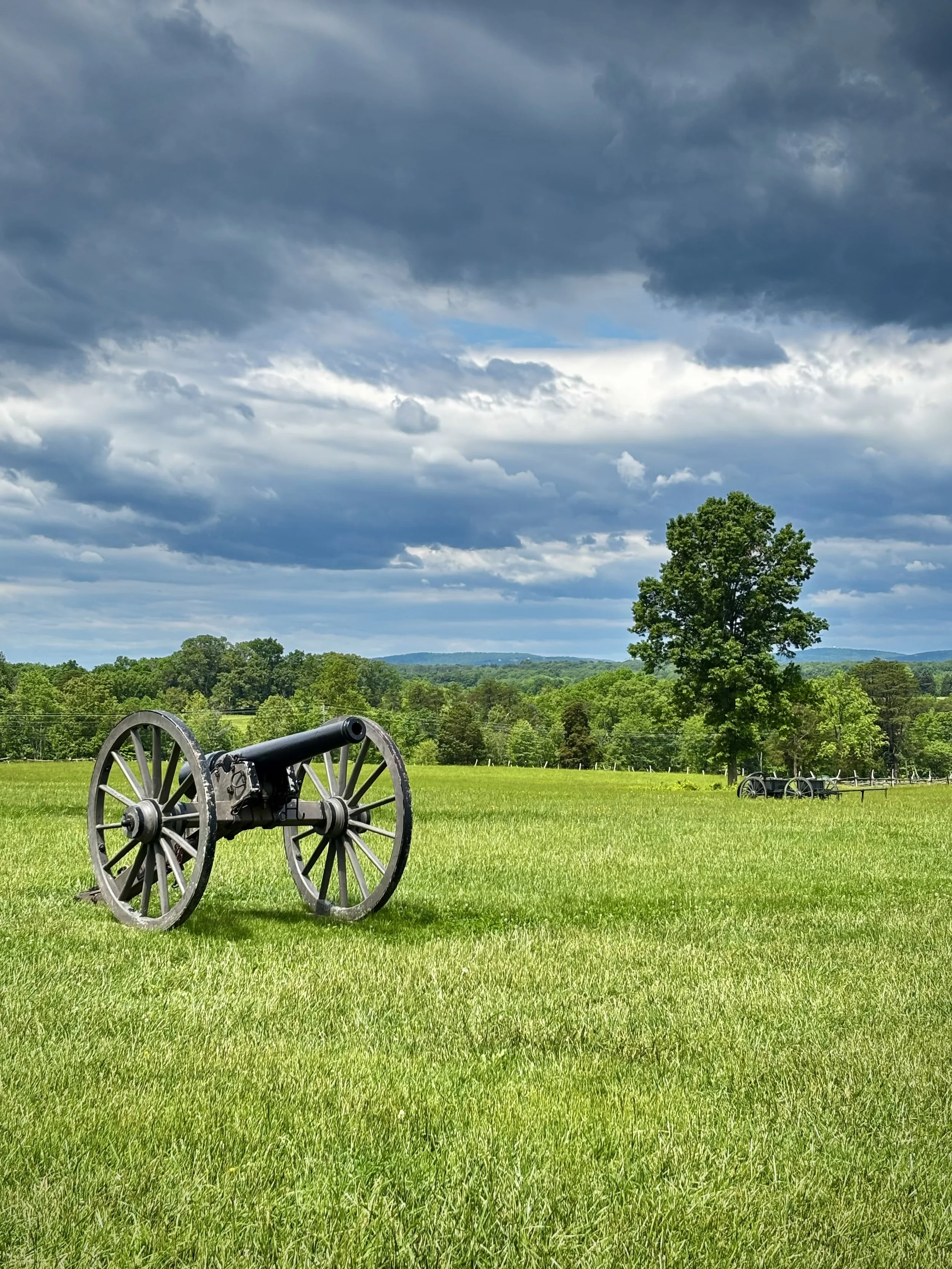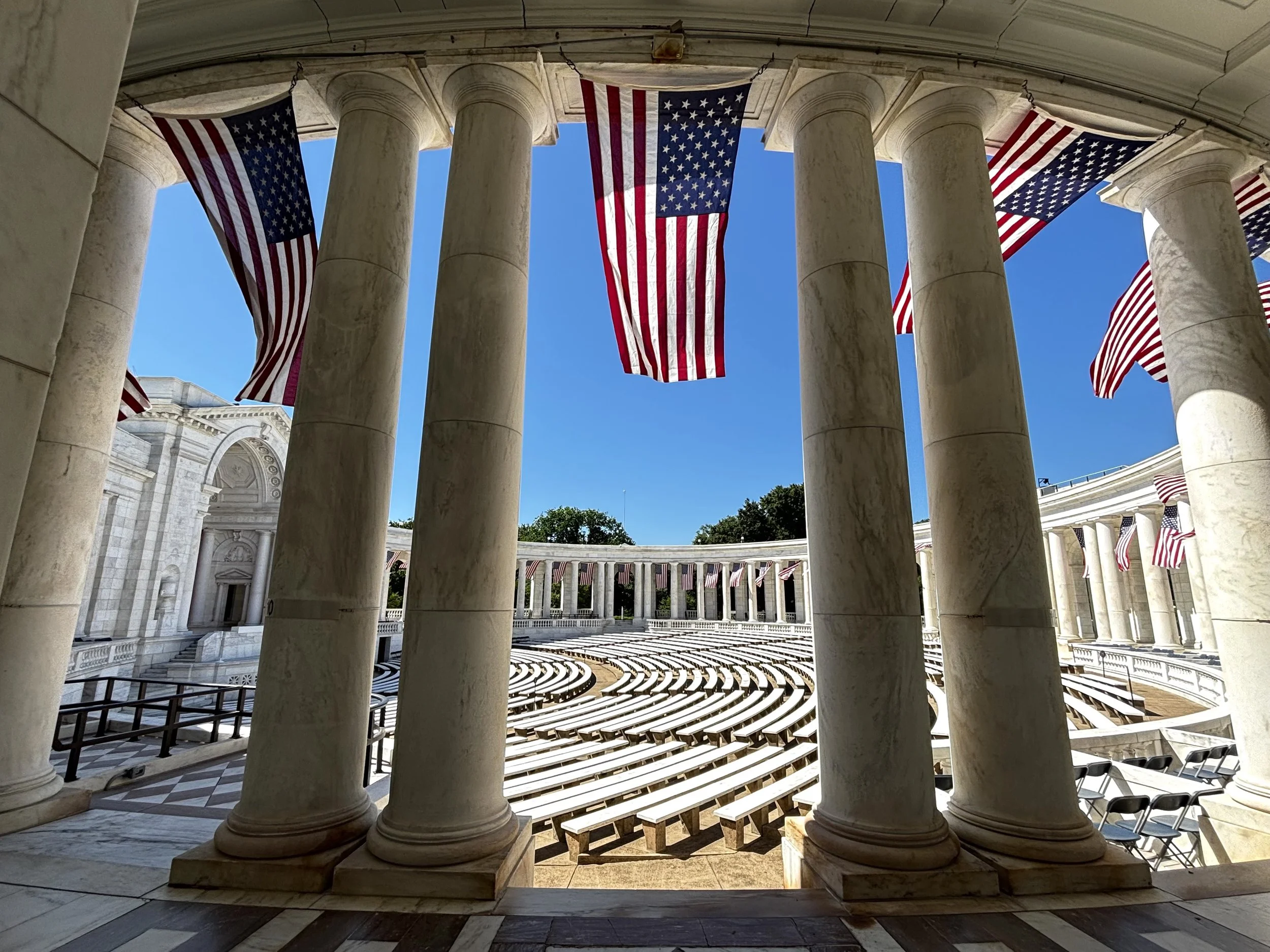Washington, D.C.
Washington Monument
Up next D.C.
Washington is, of course, a city rich in history. So, we were excited to get there and learn as much as we could. Well, upon arriving in our nation’s capital, we got our first bit of learning, and it was a stunner!
D.C. does NOT stand for “Da Capital” WHO KNEW??
Manassas Battlefield
Manassas National Battlefield
On our way to Washington, we stopped at the Manassas National Battlefield. Manassas was the site of two Civil War battles, creatively named the first and second battles of Manassas (or Bull Run). Battle #1 was the first major confrontation of the Civil War. Strange historical note: most people believed a single battle would settle the civil war, and so civilians from both the north and south gathered to picnic on nearby hills to watch the fight. That naïve notion died quickly as the battle unfolded. The canon fire was so intense and so loud it could be heard in Washington, over 25 miles away. The battle devolved into hand-to-hand fighting, and before it was over there were nearly 5,000 casualties between the two armies. Another historical note: It was at this battle that Stonewall Jackson got his impressive nickname when a Confederate officer, in trying to rally his faltering troops, exclaimed “Look, there is Jackson standing like a stone wall!” It seemed to work as the southerners did indeed rally and won the battle. Battle #2 was significantly bloodier with roughly 22,000 casualties. This visit was an interesting experience. The battle ground was beautiful. The weather was fantastic. We had a nice picnic lunch, and we learned a ton. On the other hand, this was a site of tremendous suffering and death. It was really impactful to learn about these battles while being able to walk the actual ground where it all happened. We were fortunate in that while we were there, a troupe of actors was reenacting what civil war life was like for the soldiers involved. It added a real air of authenticity to the day.




Arlington National Cemetery
Memorial Amphitheater - dedicated in 1920.
Our first full day in the DC area was spent at Arlington National Cemetery. This is such a powerful and beautiful location. We took a tour that provided a ton of information we would have missed if touring on our own. The cemetery started out as an 1100-acre plantation owned by the wife of Robert E. Lee. We toured the Arlington house which was their home until he moved to Richmond to join the Confederacy. The Union army immediately confiscated the property and ultimately converted it to the cemetery it is today. We stopped at the Tomb of the Unknowns and watched the changing of the guard which was beautiful and emotional, kind of a microcosm of the overall experience.








Alexandria, Virginia
Alexandria
We absolutely loved Old Town Alexandria. This is one of the oldest areas in D.C., dating back to before the revolution. It is rich in history and incredibly charming. It’s filled with cute boutiques, restaurants, shops, and historical sites. If you love shopping, King Street is for you. We stopped in at the visitor center and grabbed a map for their walking tour. While the town is easily walkable, they also have a cool hop on/hop off trolley. The town has many houses, churches and taverns dating back to the 1700’s which makes for incredible history and architecture. George Washington spent a lot of time in Alexandria. He surveyed much of the town, and there are several historic locations tied to him.
Spite House
One of our favorite highlights was the Spite house. Its claim to fame isn’t its age (built in 1830). It is the fact that it is the skinniest house in America at only 7’ wide.
If, you’re anything like John, eating is consistently high on your list of priorities. Fortunately, Alexandria has plenty of restaurant options to choose from. We had lunch at Cooper Mill at a nice outside table overlooking the waterfront. Mack rather enjoyed the smoked salmon (though Chick-fil-a grilled nuggets might be a closer runner up). All in all, this was a wonderful little area that is high on our list of favorite cities.







Lincoln Memorial
Monuments at Night
One of the best parts of D.C. must be visiting the monuments. Whether it is a presidential monument, a war memorial, or a tribute to someone or something important in our history, each site carries a definite weight of significance. We visited the monuments/memorials for Jefferson, Lincoln, Washington, MLK jr., and three major wars (Vietnam, Korea, WW2). Each of them was impressive, informative, and moving in their own way. No matter when you see them, they are incredibly meaningful. If, however, you want to see them in a different light, visit them at night. As the sun descends, a breathtaking transformation occurs as the already beautiful monuments begin to glow. Somehow after dark their beauty, significance, and impact seem magnified. For some, like the Jefferson and Lincoln memorials, they are simply more striking. For others, like the Vietnam and Korean War memorials, the emotion of these places is greatly amplified. You can’t help but feel a weight of grief and an appreciation of the sacrifices that these individuals made for our country and for us. So, if you ask us what is the one thing you should do in D.C., this would be our number one recommendation!












WWII, Vietnam, Lincoln, Korea, Jefferson, MLK
National Museum of the American Indian
Smithsonian Museum(s)
Visiting “the Smithsonian” was high on our list of things to do in D.C. As most people know, there actually isn’t just one Smithsonian to visit; there are 21 distinct museums. Obviously, hitting all of them isn’t something you can do in one trip, especially if you’re only on the ground for a few days. So, how to decide? Well, that is a personal question that only you can answer. Most of the museums are located around the perimeter of the national mall. Here is a map. This helps if you are trying to hit a few in the same day, which is feasible. We each picked two and landed on the Air and Space, American Indian, Contemporary Art, and the American History Museums. One piece of advice we would have is not to assume you know what a museum will be like. For example, we hit the American History Museum as a time filler between some of the others. It turned out to be very different, and more fascinating, than what we were expecting. We enjoyed each museum we visited and, almost universally, each was better than we had expected. It was a full day on our feet, but definitely worth it.












UP NEXT…CAPE CHARLES!








